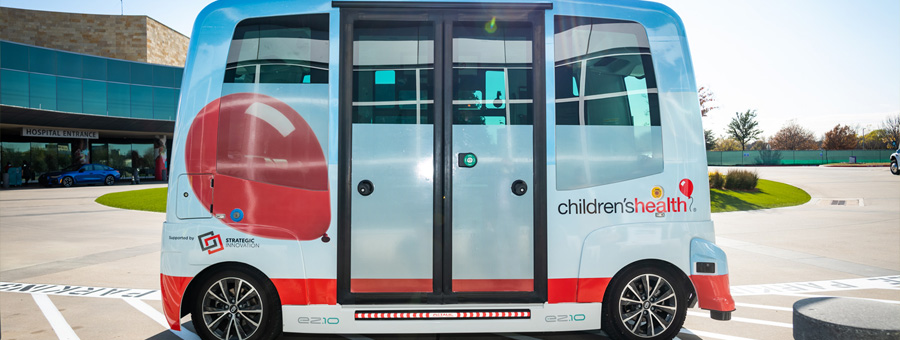When construction activities around a large expansion project on the Plano, Texas, campus of Children’s Health temporarily eliminated a significant portion of its staff and visitor parking, hospital leaders faced a problem getting people to and from the interim remote parking garage.
By choosing a self-driving, electric-powered shuttle, leaders at Children’s Health say they’re helping generations to come. “Our motto is to make life better for children,” says Frank Castro, parking and transportation manager. “So, when we are looking to solve any problem, we're always looking for a sustainable way of doing that—this seems to fit the bill.”
Environmental benefits outweigh challenges
Children’s Medical Center Plano launched the autonomous shuttle in December 2021 following two years of planning and collaboration with Toyota Financial Services and Easy Mile, the vehicle’s supplier. The six-passenger shuttle is fully automated and programmed with sensors to handle all the duties of a typical bus, including a built-in wheelchair ramp. Though the vehicle handles the driving duties, Children’s Health staffs an operator onboard to ensure passenger safety during this initial phase of the program.
Castro says getting the program rolling did present some challenges for his team. They worked closely with the National Highway Traffic Safety Administration (NHTSA) for approval, although running the shuttle on the hospital’s private property did help that process flow a bit more smoothly. And while the autonomous shuttle saves about 27 gallons of gas per week compared to a traditional gas-powered shuttle vehicle, its upfront cost was higher. Castro credits Children’s Health’s commitment to sustainability for accepting—and clearing—those hurdles.
“We could've gone the old-fashioned way and just done the gas-powered shuttle with a driver on that route, but we’re saving something like 90,000 pounds of CO2 per year by operating this electric shuttle,” Castro says. “Looking at how Children's can play its part in protecting the environment and creating sustainable solutions was a big factor.”
Pilot success could spawn program expansion
Castro says feedback on the shuttle program has been positive—many riders are curious about how the technology works and kids taking the shuttle think “it’s the coolest thing” to ride in a driverless vehicle.
The autonomous shuttle currently completes about 25 trips per day and—for now—the hospital considers the Plano shuttle a pilot program to test the technology’s functionality. But driverless vehicles could someday play a larger role in the area; Castro says the city of Plano is keeping tabs on the hospital’s program to assess the feasibility of using autonomous shuttles between local business and government buildings.
Additionally, Children’s Health is considering expanding the program to its main campus in Dallas, as well as the nearby UT Southwestern Medical Center and the Parkland Pediatric Primary Care Center.
“This is something we can utilize to help a lot more folks move around in a greener manner,” Castro says. “If we were able to take all these ridership groups who are routed to different hospitals, combine them as one and do it a sustainable way, that's just a home run for everyone.”



